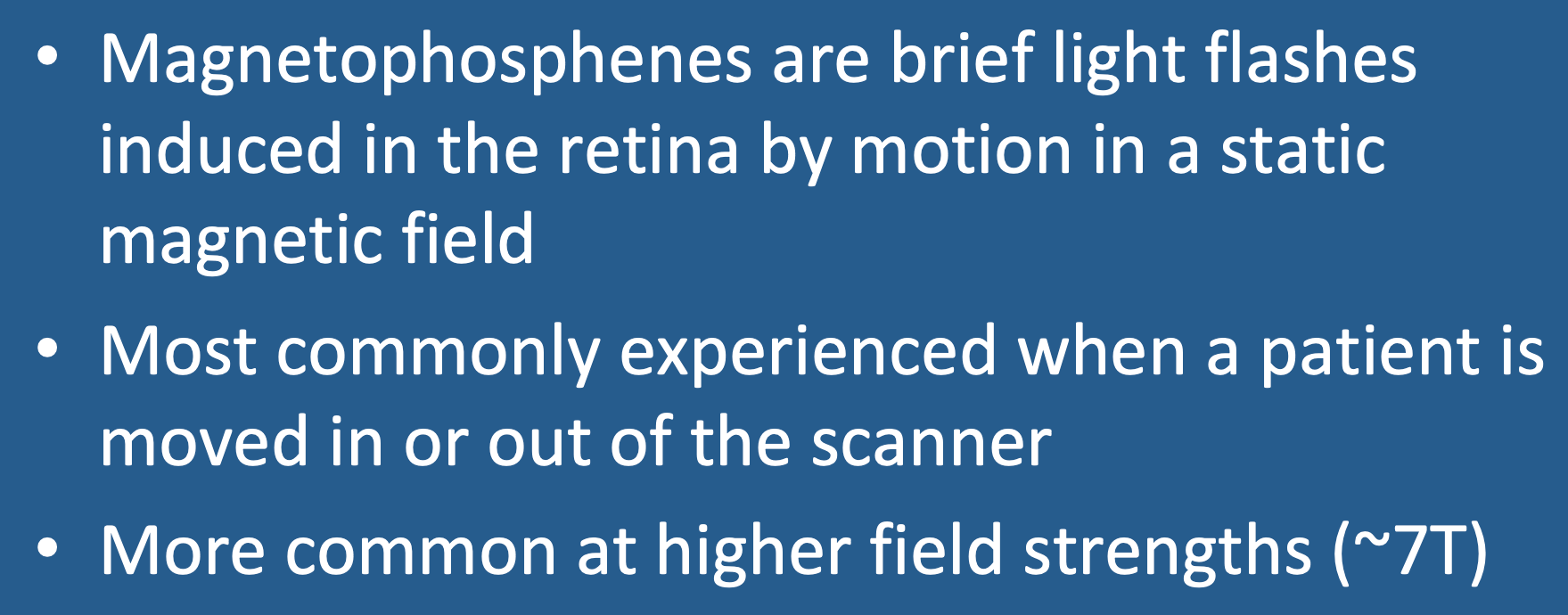|
These lights are called magneto-phosphenes and are believed to arise from direct stimulation the retina by magnetic-field induced currents. The flickers may appear as stripes, curves, waves, or rings, typically in the peripheral visual fields. They are usually white but are sometimes reported to have a bluish or yellowish tint. They occur in less than 1% of patients at 1.5 T and 3.0 T, but as high as 20% in patients at 7.0 T. Fortunately, magnetophosphenes are thought to be harmless.
|
Unlike peripheral nerve stimulation, magnetophosphenes are generated by electric fields of very low frequency (10-50 Hz) and magnitude (50-100 mV/meter). The high sensitivity of the retina to electromagnetic fields is thought to result from its structure and function, in which single light photons must be detected and where the final output of each retinal ganglion cell represents the integrated responses of over 100 individual photoreceptor cells.
Although rarely induced by gradients, magnetophosphenes are generally considered the be the result of physical movement of a person's head within the static magnetic field. Magnetophosphenes are thus usually experienced when a patient is moved in or out of the scanner. Similarly, technologists may occasionally observe magnetophosphenes when moving briskly within the scanner's fringe field.
Advanced Discussion (show/hide)»
No supplementary material yet. Check back soon!
References
Atwell D. Interaction of low frequency electric fields with the nervous system: the retina as a model system. Radiat Prot Dosimetry 2003; 106:341-348. [DOI Link]
Friebe B, Wollrab A, Thormann M, et al. Sensory perceptions of individuals exposed to the static field of a 7T MRI: a controlled blinded study. J Magn Reson Imaging 2015; 41:1675-1681. [DOI link]
Geddes LA. Retrospectoscope. The history of magnetophosphenes. IEEE Engineering in Medicine and Biology Magazine 2008; 27(4):101-102. [DOI link]
Grant A, Metzger GJ, van de Moortele P-F, et al. 10.5 T MRI static field effects on human cognitive, vestibular, and physiological function. Magn Reson Imaging 2020; 73:163-176. [DOI LINK]
Lövsund P, Oberg PA, Nilsson SEG, Reuter T. Magnetophosphenes: a quantitative analysis of thresholds. Med & Biol Eng & Comput 1980; 18:326-334. [DOI link]
Seidel D, Knoll M, Eichmeier J. Anregung von subjektiven Lichterscheinungen (Phosphenen) beim Menschen durch magnetische Sinusfelder. Pflügers Archiv 1968; 299:11-18. [DOI link]
Setsompop K, Kimmlingen R, Eberlein E, et al. Pushing the limits of in vivo diffusion MRI for the Human Connectome Project. Neuroimage 2013; 80:220-233. [DOI link] (first report of magnetophosphenes generated by 5-7 ms rise time gradients at 3.0 T)
Weintraub MI, Khouri A, Cole SP. Biologic effects of 3 Tesla (T) MR imaging comparing traditional 1.5T and 0.6 T in 1023 consecutive outpatients. J Neuroimaging 2007; 17:241-245. [DOI link]
Atwell D. Interaction of low frequency electric fields with the nervous system: the retina as a model system. Radiat Prot Dosimetry 2003; 106:341-348. [DOI Link]
Friebe B, Wollrab A, Thormann M, et al. Sensory perceptions of individuals exposed to the static field of a 7T MRI: a controlled blinded study. J Magn Reson Imaging 2015; 41:1675-1681. [DOI link]
Geddes LA. Retrospectoscope. The history of magnetophosphenes. IEEE Engineering in Medicine and Biology Magazine 2008; 27(4):101-102. [DOI link]
Grant A, Metzger GJ, van de Moortele P-F, et al. 10.5 T MRI static field effects on human cognitive, vestibular, and physiological function. Magn Reson Imaging 2020; 73:163-176. [DOI LINK]
Lövsund P, Oberg PA, Nilsson SEG, Reuter T. Magnetophosphenes: a quantitative analysis of thresholds. Med & Biol Eng & Comput 1980; 18:326-334. [DOI link]
Seidel D, Knoll M, Eichmeier J. Anregung von subjektiven Lichterscheinungen (Phosphenen) beim Menschen durch magnetische Sinusfelder. Pflügers Archiv 1968; 299:11-18. [DOI link]
Setsompop K, Kimmlingen R, Eberlein E, et al. Pushing the limits of in vivo diffusion MRI for the Human Connectome Project. Neuroimage 2013; 80:220-233. [DOI link] (first report of magnetophosphenes generated by 5-7 ms rise time gradients at 3.0 T)
Weintraub MI, Khouri A, Cole SP. Biologic effects of 3 Tesla (T) MR imaging comparing traditional 1.5T and 0.6 T in 1023 consecutive outpatients. J Neuroimaging 2007; 17:241-245. [DOI link]
Related Questions
I've heard MRI may cause a patient's arm or leg to twitch during scanning. What causes this? Is it dangerous?
I've heard MRI may cause a patient's arm or leg to twitch during scanning. What causes this? Is it dangerous?

